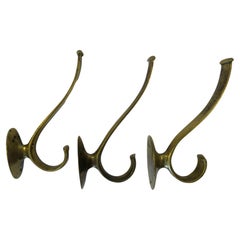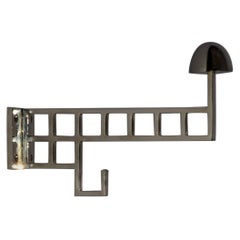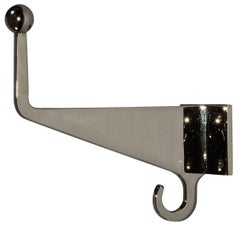Wiener Werkstatte Hook
Early 20th Century Austrian Art Nouveau Coat Racks and Stands
Brass
2010s Austrian Jugendstil Wardrobes and Armoires
Brass
2010s Austrian Jugendstil Decorative Art
Brass
People Also Browsed
21st Century and Contemporary Italian Modern Wall Lights and Sconces
Cotton
Vintage 1950s Swedish Scandinavian Modern Wall Lights and Sconces
Brass
21st Century and Contemporary Italian Mid-Century Modern Floor Lamps
Aluminum
2010s German Mid-Century Modern Chandeliers and Pendants
Brass
2010s American Minimalist Wardrobes and Armoires
Oak
Vintage 1930s Czech Art Deco Stools
Fabric, Beech
Mid-20th Century American Mid-Century Modern Coffee and Cocktail Tables
Walnut
Mid-20th Century French Mid-Century Modern Lounge Chairs
Oak
Vintage 1960s Italian Mid-Century Modern Dining Room Tables
Brass, Iron
Vintage 1970s American American Craftsman Console Tables
Maple
Late 20th Century Italian Bauhaus Lounge Chairs
Chrome
Vintage 1960s Italian Other Wall Lights and Sconces
Brass
Early 20th Century Austrian Jugendstil Lounge Chairs
Leather, Wood
Vintage 1940s Italian Coat Racks and Stands
Brass
Late 20th Century Italian Mid-Century Modern Vases
Blown Glass, Murano Glass
Vintage 1970s Italian Mid-Century Modern Table Lamps
Brass
Wiener Werkstätte for sale on 1stDibs
Born from the Vienna Secession art movement in Austria during the early 20th century, the Wiener Werkstätte helped to cement Art Nouveau style and culture in Viennese art. Wiener Werkstätte furniture included armchairs, cabinets and table lamps, with production extending to other crafts such as ceramics, jewelry and fashion. The Werkstätte also boasted a large graphic arts department, which created nearly 1,000 unique postcards during the organization’s run.
Austrian architect Josef Hoffmann, painter Koloman Moser and industrialist Fritz Waerndorfer established the collective in opposition to the dominant trends in Viennese art. The artistic community was then largely directed by the Association of Austrian Artists, which had firm control over the creation and distribution of Austrian art. The collective’s style pushed back against traditional artistic preferences, instead favoring clear, bold lines and often-exaggerated, vibrant colors.
Employing over 100 people, including several master craftsmen, the Werkstätte formed relationships and alliances with a number of firms and stores, which sold and commissioned new work from the workshop.
As the Wiener Werkstätte’s mission aligned with emerging British sensibilities regarding art, many British artists worked closely with the collective. Some major Austrian artists collaborated with the collective, without officially joining, such as painter Gustav Klimt.
The Werkstätte’s artistic range was extensive and eclectic, with the organization producing a wide variety of furniture. In 1932, the global economic collapse forced it to shut down. With the outbreak of WWII soon to follow, the Wiener Werkstätte never reopened. Its legacy lived on, however, in the numerous artists and craftspeople who carried forward its commitment to progressive cultural and creative endeavors.
On 1stDibs, find antique Wiener Werkstätte lighting, seating and storage pieces.
A Close Look at Art Nouveau Furniture
In its sinuous lines and flamboyant curves inspired by the natural world, antique Art Nouveau furniture reflects a desire for freedom from the stuffy social and artistic strictures of the Victorian era. The Art Nouveau movement developed in the decorative arts in France and Britain in the early 1880s and quickly became a dominant aesthetic style in Western Europe and the United States.
ORIGINS OF ART NOUVEAU FURNITURE DESIGN
- Emerged during the late 19th century
- Popularity of this modernizing style declined in the early 20th century
- Originated in France and Britain but variants materialized elsewhere
- Informed by Rococo, Pre-Raphaelite art, Japanese art (and Japonisme), Arts and Crafts; influenced modernism, Bauhaus
CHARACTERISTICS OF ART NOUVEAU FURNITURE DESIGN
- Sinuous, organic and flowing lines
- Forms that mimic flowers and plant life
- Decorative inlays and ornate carvings of natural-world motifs such as insects and animals
- Use of hardwoods such as oak, mahogany and rosewood
ART NOUVEAU FURNITURE DESIGNERS TO KNOW
ANTIQUE ART NOUVEAU FURNITURE ON 1STDIBS
Art Nouveau — which spanned furniture, architecture, jewelry and graphic design — can be easily identified by its lush, flowing forms suggested by flowers and plants, as well as the lissome tendrils of sea life. Although Art Deco and Art Nouveau were both in the forefront of turn-of-the-20th-century design, they are very different styles — Art Deco is marked by bold, geometric shapes while Art Nouveau incorporates dreamlike, floral motifs. The latter’s signature motif is the "whiplash" curve — a deep, narrow, dynamic parabola that appears as an element in everything from chair arms to cabinetry and mirror frames.
The visual vocabulary of Art Nouveau was particularly influenced by the soft colors and abstract images of nature seen in Japanese art prints, which arrived in large numbers in the West after open trade was forced upon Japan in the 1860s. Impressionist artists were moved by the artistic tradition of Japanese woodblock printmaking, and Japonisme — a term used to describe the appetite for Japanese art and culture in Europe at the time — greatly informed Art Nouveau.
The Art Nouveau style quickly reached a wide audience in Europe via advertising posters, book covers, illustrations and other work by such artists as Aubrey Beardsley, Henri de Toulouse-Lautrec and Alphonse Mucha. While all Art Nouveau designs share common formal elements, different countries and regions produced their own variants.
In Scotland, the architect Charles Rennie Mackintosh developed a singular, restrained look based on scale rather than ornament; a style best known from his narrow chairs with exceedingly tall backs, designed for Glasgow tea rooms. Meanwhile in France, Hector Guimard — whose iconic 1896 entry arches for the Paris Metro are still in use — and Louis Majorelle produced chairs, desks, bed frames and cabinets with sweeping lines and rich veneers.
The Art Nouveau movement was known as Jugendstil ("Youth Style") in Germany, and in Austria the designers of the Vienna Secession group — notably Koloman Moser, Josef Hoffmann and Joseph Maria Olbrich — produced a relatively austere iteration of the Art Nouveau style, which mixed curving and geometric elements.
Art Nouveau revitalized all of the applied arts. Ceramists such as Ernest Chaplet and Edmond Lachenal created new forms covered in novel and rediscovered glazes that produced thick, foam-like finishes. Bold vases, bowls and lighting designs in acid-etched and marquetry cameo glass by Émile Gallé and the Daum Freres appeared in France, while in New York the glass workshop-cum-laboratory of Louis Comfort Tiffany — the core of what eventually became a multimedia decorative-arts manufactory called Tiffany Studios — brought out buoyant pieces in opalescent favrile glass.
Jewelry design was revolutionized, as settings, for the first time, were emphasized as much as, or more than, gemstones. A favorite Art Nouveau jewelry motif was insects (think of Tiffany, in his famed Dragonflies glass lampshade).
Like a mayfly, Art Nouveau was short-lived. The sensuous, languorous style fell out of favor early in the 20th century, deemed perhaps too light and insubstantial for European tastes in the aftermath of World War I. But as the designs on 1stDibs demonstrate, Art Nouveau retains its power to fascinate and seduce.
There are ways to tastefully integrate a touch of Art Nouveau into even the most modern interior — browse an extraordinary collection of original antique Art Nouveau furniture on 1stDibs, which includes decorative objects, seating, tables, garden elements and more.
Materials: Brass Furniture
Whether burnished or lacquered, antique, new and vintage brass furniture can elevate a room.
From traditional spaces that use brass as an accent — by way of brass dining chairs or brass pendant lights — to contemporary rooms that embrace bold brass decor, there are many ways to incorporate the golden-hued metal.
“I find mixed metals to be a very updated approach, as opposed to the old days, when it was all shiny brass of dulled-out silver tones,” says interior designer Drew McGukin. “I especially love working with brass and blackened steel for added warmth and tonality. To me, aged brass is complementary across many design styles and can trend contemporary or traditional when pushed either way.”
He proves his point in a San Francisco entryway, where a Lindsey Adelman light fixture hangs above a limited-edition table and stools by Kelly Wearstler — also an enthusiast of juxtapositions — all providing bronze accents. The walls were hand-painted by artist Caroline Lizarraga and the ombré stair runner is by DMc.
West Coast designer Catherine Kwong chose a sleek brass and lacquered-parchment credenza by Scala Luxury to fit this San Francisco apartment. “The design of this sideboard is reminiscent of work by French modernist Jean Prouvé. The brass font imbues the space with warmth and the round ‘portholes’ provide an arresting geometric element.”
Find antique, new and vintage brass tables, case pieces and other furnishings now on 1stDibs.


